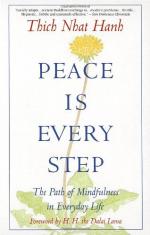
|
| Name: _________________________ | Period: ___________________ |
This test consists of 15 multiple choice questions and 5 short answer questions.
Multiple Choice Questions
1. What do negative feelings leave behind if they are not faced?
(a) Positive acceptance.
(b) Relief, acceptance, and peace.
(c) Negativity.
(d) Destructive feelings, thoughts, and behaviors.
2. In "Transforming Feelings", who/what is analogous to emotion?
(a) Buddha.
(b) The crying child.
(c) Mindfulness.
(d) The mother.
3. For whom should one feel compassion?
(a) Those who suffer and those who cause us to suffer.
(b) Only those who do not cause us to suffer.
(c) Only those who suffer.
(d) Only those who are truly grateful.
4. How many years does it take for nuclear waste to become a flower?
(a) One quarter of a million.
(b) One million.
(c) One half of a million.
(d) Infinitely many.
5. How can one find peace and love when feeling angry?
(a) By ignoring the anger.
(b) By acting on the feeling of anger.
(c) By recognizing that anger is fleeting.
(d) By recognizing anger as a source of positive energy.
6. In "Transforming Feelings", who/what symbolizes mindfulness?
(a) The mother.
(b) Buddha.
(c) The reader.
(d) The crying child.
7. In which river did the author wash his face?
(a) The Mississippi River.
(b) The Ohio River.
(c) The Charles River.
(d) The Nile River.
8. What does Hanh view as the best investment one can make?
(a) Cultivating a lifelong commitment.
(b) Cultivating a relationship with a friend.
(c) Maintaining one's health.
(d) Nurturing one's spiritual interests.
9. What is the result of compassion towards another who is suffering?
(a) Love and peace.
(b) Unconditional love.
(c) Eternal gratitude.
(d) Joy and peace.
10. According to Hanh, what is the only tool useful in changing a situation?
(a) Mindful living.
(b) Communication.
(c) Understanding.
(d) Faith.
11. Who used mindful living in Vietnam to act on the suffering of others?
(a) The Dalai Lama.
(b) The South Vietnamese.
(c) The author and his monastic fellows.
(d) The author.
12. What technique discussed in "Cooking the Potato" transforms anger into a positive force?
(a) Mediation.
(b) Meditation.
(c) Nurturing.
(d) Breathing.
13. What else must exist for wealth to be possible in the world?
(a) Education.
(b) Power.
(c) Peace.
(d) Poverty.
14. According to Hanh, what happens to anger when one pounds a pillow?
(a) It is negated.
(b) It becomes more intense.
(c) It subsides temporarily.
(d) It subsides completely.
15. According to Hanh, which of the following are feelings that are experienced by humans during life?
(a) Love and hate.
(b) Pleasant and neutral.
(c) Harmless and harmful.
(d) Love and fear.
Short Answer Questions
1. Who/what lives thanks to the "second heart"?
2. What term means "the essence of a person's true nature"?
3. What is Hanh's lament in "It is a Great Joy to hold Your Grandchild"?
4. According Hanh, if one item is removed from the universe, how many others will cease to exist?
5. What happens when one is cut off from nature?
|
This section contains 462 words (approx. 2 pages at 300 words per page) |

|




